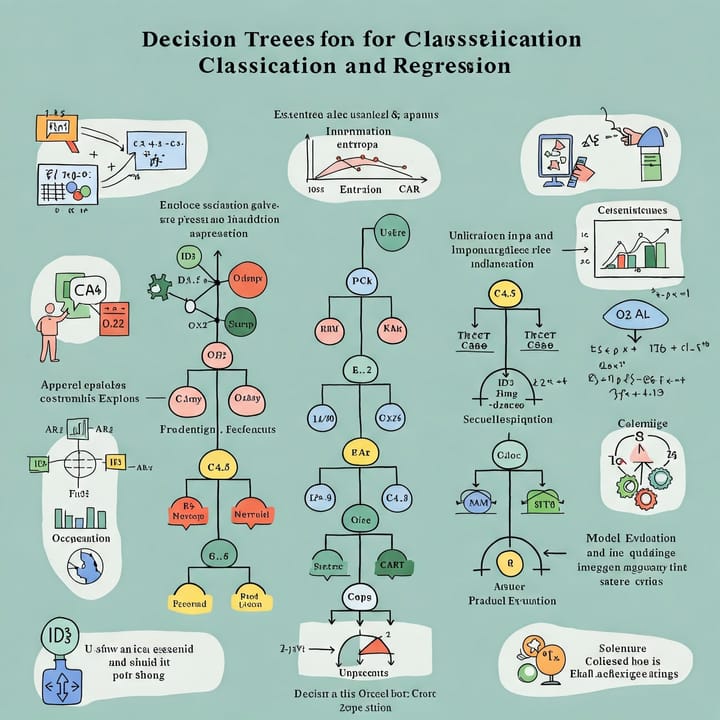Decoding Model Performance: Your Ultimate Guide to Machine Learning Evaluation Metrics
Building a machine learning model is only half the battle. The crucial next step is evaluating its performance – and that's where things can get surprisingly complex. "Performance" isn't a one-size-fits-all concept. Are you more concerned with minimizing false positives or false negatives? Are you predicting categories or continuous values? Choosing the right evaluation metric is paramount. This article provides a comprehensive guide to common evaluation metrics, their mathematical formulations, their strengths and weaknesses, and, most importantly, how to choose the right one for your specific problem.
1. Classification Metrics
These metrics are used for evaluating models that predict categorical outcomes (e.g., spam/not spam, cat/dog, disease/no disease).
- True Positives (TP): Correctly predicted positive cases.
- True Negatives (TN): Correctly predicted negative cases.
- False Positives (FP): Incorrectly predicted positive cases (Type I error).
- False Negatives (FN): Incorrectly predicted negative cases (Type II error).
- 1.2 Accuracy:
- Definition: The proportion of correctly classified instances out of all instances.
- Equation: Accuracy = (TP + TN) / (TP + TN + FP + FN)
- Strengths: Simple and intuitive; a good overall measure when classes are balanced.
- Weaknesses: Misleading for imbalanced datasets. If 99% of your data is "not spam" and your model always predicts "not spam," it will have 99% accuracy, but it's useless!
- When to Use: Balanced datasets; when the cost of false positives and false negatives is roughly equal.
- 1.3 Precision:
- Definition: The proportion of correctly predicted positive cases out of all instances predicted as positive. Measures the model's ability to avoid false positives.
- Equation: Precision = TP / (TP + FP)
- Strengths: Useful when the cost of false positives is high.
- Weaknesses: Can be high even if the model misses many positive cases (high false negatives).
- When to Use: Spam detection (you don't want to miss important emails), medical diagnosis (you don't want to falsely diagnose a healthy person).
- 1.4 Recall (Sensitivity, True Positive Rate):
- Definition: The proportion of correctly predicted positive cases out of all actual positive cases. Measures the model's ability to find all the positive instances.
- Equation: Recall = TP / (TP + FN)
- Strengths: Useful when the cost of false negatives is high.
- Weaknesses: Can be high even if the model has many false positives.
- When to Use: Fraud detection (you don't want to miss any fraudulent transactions), medical diagnosis (you don't want to miss a sick patient).
- 1.5 F1-Score:
- Definition: The harmonic mean of precision and recall. Provides a balance between precision and recall.
- Equation: F1-Score = 2 * (Precision * Recall) / (Precision + Recall)
- Strengths: A good single metric when you want to balance precision and recall.
- Weaknesses: Treats precision and recall equally; may not be ideal if one is more important than the other.
- When to Use: When you need a good balance between precision and recall, and there's an uneven class distribution.
- 1.6 F-beta Score
- Definition The weighted harmonic mean of precision and recall. Allows you to weigh recall as more or less than precision.
- Equation: Fβ-Score = (1 + β²) * ((Precision * Recall) / ((β² * Precision) + Recall)
- Strengths: Allows control over precision vs. recall importance.
- Weaknessess: Can be hard to interpret what a good value would be.
- When to Use: When recall is β times more important than precision.
- 1.7 ROC AUC (Receiver Operating Characteristic - Area Under the Curve):
- Definition: The ROC curve plots the True Positive Rate (Recall) against the False Positive Rate (FPR = FP / (FP + TN)) at various threshold settings. AUC is the area under this curve.
- Equation: AUC is calculated by integrating the ROC curve. No single formula; it's computed numerically.
- Strengths: Provides a measure of the model's ability to discriminate between classes, regardless of the classification threshold. Insensitive to class imbalance.
- Weaknesses: Can be less informative when dealing with highly imbalanced datasets; doesn't directly tell you about precision or recall.
- When to Use: When you care about the model's ability to rank positive instances higher than negative instances, and you want a threshold-independent measure of performance. Good for comparing different models.
- 1.8. Precision-Recall Curve and AUPRC
- Definition: The Precision-Recall curve plots precision against recall. The AUPRC (Area under the precision recall curve) gives a measure of model performance that is focused on the positive class.
- Equation: AUPRC is calculated by intergrating the precision-recall curve.
- Strengths: Useful when the positive class is more important, or when the positive class is the minor class.
- Weaknesses: Sensitive to class imbalance.
- When to use: Fraud Detection, Anomaly Detection.
1.1 Confusion Matrix:The foundation for many classification metrics is the confusion matrix. It's a table that summarizes the performance of a classification model by showing the counts of:
| Predicted Positive | Predicted Negative |
--------------|--------------------|--------------------|
Actual Positive | TP | FN |
Actual Negative | FP | TN |
2. Regression Metrics
These metrics are used for evaluating models that predict continuous outcomes (e.g., house prices, stock prices, temperature).
- 2.1 Mean Squared Error (MSE):
- Definition: The average of the squared differences between the predicted and actual values.
- Equation: MSE = (1/n) * Σ(yᵢ - ŷᵢ)² (where yᵢ is the actual value, ŷᵢ is the predicted value, and n is the number of data points)
- Strengths: Widely used; easy to understand; differentiable (useful for optimization).
- Weaknesses: Sensitive to outliers (because of the squaring); units are squared, making interpretation less intuitive.
- When to Use: General-purpose regression metric; when large errors are particularly undesirable.
- 2.2 Root Mean Squared Error (RMSE):
- Definition: The square root of the MSE.
- Equation: RMSE = √(MSE)
- Strengths: Same advantages as MSE, but in the same units as the target variable, making it more interpretable.
- Weaknesses: Still sensitive to outliers.
- When to Use: Same as MSE, but preferred when you want the error in the original units.
- 2.3 Mean Absolute Error (MAE):
- Definition: The average of the absolute differences between the predicted and actual values.
- Equation: MAE = (1/n) * Σ|yᵢ - ŷᵢ|
- Strengths: Less sensitive to outliers than MSE/RMSE.
- Weaknesses: Not differentiable at zero (can be an issue for some optimization algorithms).
- When to Use: When outliers are present and you don't want them to overly influence the evaluation.
- 2.4 R-squared (Coefficient of Determination):
- Definition: Represents the proportion of variance in the target variable that is explained by the model. Ranges from 0 to 1 (or -∞ to 1 in some cases).
- Equation: R² = 1 - (SSres / SStot)
- SSres (Residual Sum of Squares) = Σ(yᵢ - ŷᵢ)²
- SStot (Total Sum of Squares) = Σ(yᵢ - ȳ)² (where ȳ is the mean of the actual values)
- Strengths: Provides a measure of how well the model fits the data relative to a simple baseline (predicting the mean). Easy to interpret.
- Weaknesses: Can be misleading for non-linear relationships; can be artificially high if the model overfits; doesn't tell you about the magnitude of the errors.
- When to Use: When you want to assess the overall goodness of fit of the model and compare it to a baseline. Not the best choice as the sole metric.
- Note: Adjusted R-squared is a modified version that accounts for the number of predictors in the model, penalizing overfitting.
- 2.5. Mean Squared Logarithmic Error (MSLE):
- Definition: Like MSE, but uses the logarithm of the predicted and true values.
- Equation: MSLE = (1/n) * Σ(log(yᵢ + 1) - log(ŷᵢ + 1))²
- Strengths: Reduces impact of outliers. Useful for when the target variable has exponential growth.
- Weaknesses: Cannot be used if the target values are less than or equal to zero.
- When to Use: When the target spans several orders of magnitude.
3. Choosing the Right Metric: Key Considerations
- Problem Type: Classification or regression?
- Class Imbalance: Are the classes in your classification problem balanced or imbalanced?
- Cost of Errors: What are the consequences of false positives vs. false negatives? Are some errors more costly than others?
- Business Goals: What are you ultimately trying to achieve with your model? The metric should align with your business objectives.
- Interpretability: Chose a metric that is easily understandable by stakeholders.
Example Scenarios:
- Spam Detection: High precision is crucial (you don't want to misclassify important emails as spam). Recall is also important (you don't want to miss spam). F1-score or AUPRC might be good choices.
- Fraud Detection: High recall is paramount (you want to catch all fraudulent transactions). Precision is also important, but you might be willing to tolerate a higher false positive rate to minimize false negatives.
- Medical Diagnosis: Depends on the specific disease. For life-threatening diseases, high recall is critical (minimize false negatives). For less serious conditions, a balance between precision and recall (F1-score) might be preferred.
- House Price Prediction: RMSE or MAE are common choices, as they provide an interpretable measure of the average prediction error in the original units (dollars).
- Customer Churn Prediction: ROC AUC can be useful to assess the model's ability to rank customers by their likelihood of churning.
4. Conclusion:
Choosing the right evaluation metric is a critical step in the machine learning process. It's not just about picking a number; it's about understanding what that number means in the context of your specific problem and your business goals. By carefully considering the characteristics of each metric and the trade-offs involved, you can gain a much deeper understanding of your model's performance and build systems that are truly effective. This, in turn, enables you to make more informed decisions, refine your models, and ultimately achieve better outcomes.
References
[1] Powers, D. M. W. (2011). Evaluation: from precision, recall and F-measure to ROC, informedness, markedness & correlation. Journal of Machine Learning Technologies, 2(1), 37-63.
[2] Fawcett, T. (2006). An introduction to ROC analysis. Pattern Recognition Letters, 27(8), 861-874.
[3] Bradley, A. P. (1997). The use of the area under the ROC curve in the evaluation of machine learning algorithms. Pattern Recognition, 30(7), 1145-1159.
[4] Hastie, T., Tibshirani, R., & Friedman, J. (2009). The Elements of Statistical Learning: Data Mining, Inference, and Prediction (2nd ed.). Springer.
[5] James, G., Witten, D., Hastie, T., & Tibshirani, R. (2013). An Introduction to Statistical Learning: with Applications in R. Springer.
[6] Davis, J., & Goadrich, M. (2006). The relationship between Precision-Recall and ROC curves. In Proceedings of the 23rd international conference on Machine learning (pp. 233-240).



Comments ()